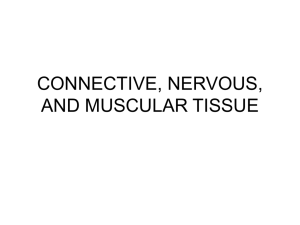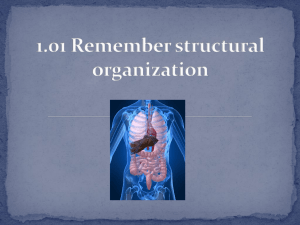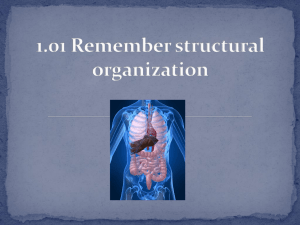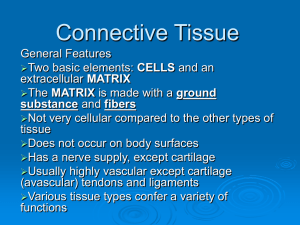Connective Tissue Types: A Biology Presentation
advertisement
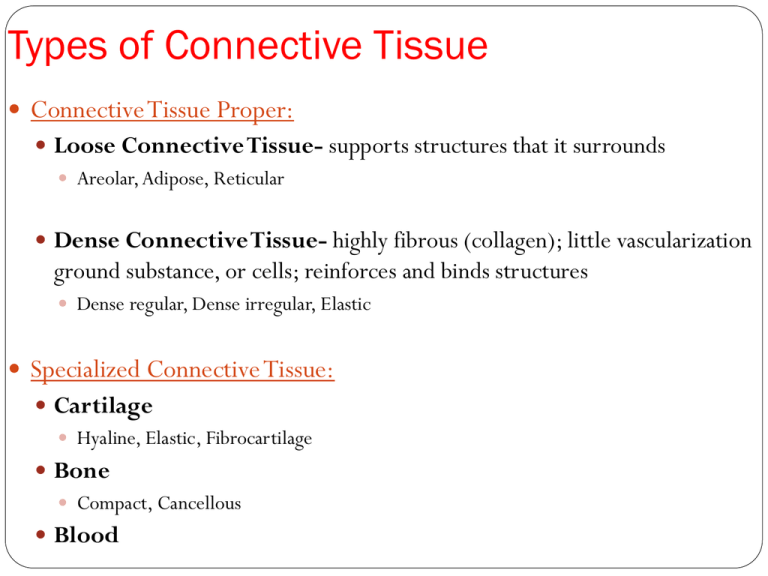
Types of Connective Tissue Connective Tissue Proper: Loose Connective Tissue- supports structures that it surrounds Areolar, Adipose, Reticular Dense Connective Tissue- highly fibrous (collagen); little vascularization ground substance, or cells; reinforces and binds structures Dense regular, Dense irregular, Elastic Specialized Connective Tissue: Cartilage Hyaline, Elastic, Fibrocartilage Bone Compact, Cancellous Blood Most common type of connective tissue Surrounds every organ, connects skin to muscle, envelops blood vessels, nerves, and lymph nodes Acts to support and cushion organs and other delicate structures. Predominant cell is fibroblast Flexible, moderately elastic, but tears easily compared to other connective tissue. Has “open” spaces that are filled with fluid and viscous ground substance GS- Hyaluronic acid Nutrients and wastes easily move in and out of bloodstream; foreign invaders get trapped Hyaluronidase allows WBCs to pass through easily Filling of open spaces during trauma is called edema Loose Connective Tissue: Areolar Commonly known as fat Found beneath skin, between muscles, behind eyeballs, on heart surface, around joints, in bone marrow, in abdomen Energy storage, insulator, shock absorber Highly vascularized areolar tissue in which adipocytes Loose Connective Tissue: Adipose predominate Cells expand/shrivel based on amount of lipid being stored in them. May be classified as: White: Found throughout body Adipocytes change from resembling fibroblasts to filling with lipid, which swells the cell and pushes the organelles and nucleus to the side and compresses the cytosol to a rim Brown: Found in newborns and hibernating animals Site of heat production, temperature regulation Framework for spleen, liver, lymph nodes, bone marrow Called stroma Contains only one type of fiber: reticular Many fibroblasts Loose Connective Tissue: Reticular Makes up tendons and ligaments, fascia Tightly packed, parallel collagen fibers Little vascularization, slow to heal Little ground substance Fibroblasts line the collagen bundles Resists strong pulling forces in one direction. Dense Connective Tissue: Regular Found in dermis, organ capsules Forms tough capsule of joints. Collagen fibers in thicker bundles than those in dense regular connective tissue. Sheets of collagen run or stacked in different directions. Single sheet that can withstand force from many different directions. Dense Connective Tissue: Irregular Found in areas of the body that require stretching: Stomach, large airways, artery walls, bladder, between vertebrae Beneath transitional epithelium in urinary tract High concentration of elastic fibers (more than collagen) that is extremely flexible. Elastic Connective Tissue Specialized Connective Tissue: Cartilage Tough, specialized connective tissue. May be called gristle. More rigid than dense connective tissue, more flexible than bone. Prevents bones from rubbing against each other Does not contain nerves or blood vessels. Receives nutrition from perichondrium Cells are chondrocytes, matrix is a gel of chondroitin sulfate, hyaluronic acid, and chondronectin plus fluid. Fluid gives nutrients to the chondrocytes, which live in pockets called lacunae Fluid allows cartilage to be resilient and withstand compression 3 types of cartilage: Hyaline cartilage, Elastic Cartilage, Fibrocartilage Specialized Connective Tissue: Types of Cartilage Hyaline Cartilage Most common type of cartilage found in body. Found as articular cartilage at end of long bones and joints and connects ribs to the sternum. Nose, trachea, larynx Most rigid type of cartilage. Closely packed collagen fibers that make it tough but more flexible than bone. Elastic Cartilage Similar to hyaline cartilage but contains elastic fibers Give it flexibility, ability to bend Found in pinnae, ear canal, epiglottis Specialized Connective Tissue: Types of Cartilage Fibrocartilage Found between vertebrae, in pelvis, and in knee joint Thick bundles of collagen, but few chondrocytes Thicker bundles than hyaline, matrix less firm Also called osseous connective tissue Hardest and most rigid type of connective tissue Forms animal’s frame, protects organs, calcium reserve, fat storage, blood cell production Is well vascularized Structure Matrix – collagen fibers and calcium salts Canaliculi- tiny channels through matrix that allows osteocytes to communicate Lacunae- chambers where osteocytes reside Blood Supply- Haversian canals (channels in bone that carry blood supply and nerves) Cells- Osteoclasts and osteoblasts Remodel bone as needed Specialized Connective Tissue: Bone Specialized Connective Tissue: Blood Most atypical type of connective tissue. Carries nutrients and gases through the body Matrix: liquid (plasma) Fibers: few and only visible in a clot Cells: Erythrocytes (red blood cells) Leukocytes (white blood cells) Thrombocytes (platelets) Membranes Thin, protective layers that line body cavities, separate organs and cover surfaces. Epithelial sheet bound to underlying layer of connective tissue proper. Epithelium is usually bathed in liquid Four common epithelial membranes are: Mucous Serous Cutaneous Synovial Mucous Membranes (mucosa) Always found lining organs that have connection to outside environment. Digestive, respiratory, urinary, and reproductive tracts Epithelium: stratified squamous, simple columnar, transitional Covers the lamina propria (areolar connective tissue) Secretion: Produces mucus (exception: urinary tract) lubrication, defense, reduce friction Play role in monitoring and controlling what enters into body. Absorption: microvilli in digestive system Serous Membranes (serosa) Line walls and cover organs that fill closed body cavities (organs in chest and abdomen) Continuous membrane sheet that is doubled over to form a parietal and visceral layer. simple squamous epithelium + loose connective tissue Fluid is found between the two serosal layers to reduce friction. pleural, peritoneal, pericardial fluid Large amount of fluid is called effusion. Effusion in abdomen is termed ascites. Adhesions are connections between parietal and visceral layers that form when the serous membranes are damaged. Cutaneous Membranes (integument/skin) Perpetually exposed to environment. Composed of keratinized stratified squamous epithelium called epidermis Epidermis is attached to underlying dense irregular connective tissue called dermis. Synovial Membranes Line the cavities of joints Contain no epithelium composed exclusively of loose adipose connective tissue covered by collagen and fibroblasts Manufacture synovial fluid that fills the joint spaces and reduces friction and abrasion at the ends of bones.




